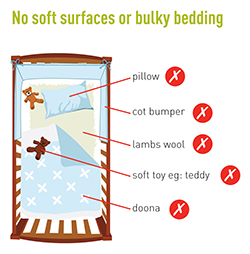Bed sharing is when a baby is brought into an adult bed for feeding or settling without the intention of sleeping. At the completion of feeding or settling, the baby is returned to its cot. Please note that parents who are tired or affected by medications (including prescribed medications or those administered in a hospital setting, for example, pain relieving medications), drugs or alcohol, may unintentionally fall asleep with the baby in bed or on a couch when bed sharing or reclining on a couch with their baby. This situation may increase the risk of SIDS.
Postnatal and Parenting
Safe sleeping, and settling newborns
Why is safe sleeping important for your baby?
SUDI (including SIDS) is the sudden unexpected death of an infant less than one year of age during sleep. The reason remains unexplained after thorough investigation, including a complete autopsy and review of the circumstances of the death and clinical history.
However, research into cases of SIDS has revealed a common thread: the infant, either at the time of death or shortly before death, shared a sleep surface with another person, usually the parent.
Situations that additionally increase the risk of SIDS include:
- The person sleeping with the baby is a smoker or affected by alcohol, drugs or medication
- The infant is sleeping with another person or parent on a couch, in a bed with thick or soft bedding e.g. waterbeds, bean bags, sagging mattresses, sofas
- The infant is sleeping with siblings (including twins, as well as older children) and/or pets
- A pillow is present in bed with children under 4 months
- The infant is aged under 12 weeks or born prematurely
- Where the baby can be trapped between the wall and bed, can fall out of bed, or could be rolled on
Many parents are unaware of these risks or have received incomplete, inaccurate or inconsistent information about creating safe sleeping environments for their infants.
Bed sharing, co-sleeping and sharing a room – the myths and risks
Sharing a sleep surface (also called co-sleeping) with your baby means falling asleep or sleeping in or on beds, sofas, mattresses or armchairs with your baby. Co-sleeping and sharing sleep surfaces with the baby with the intention of sleeping with the baby should be avoided altogether until the baby is at least six months of age and ideally until s/he is a year old.
Ramsay Health care does not allow co-sleeping in any of its hospitals.
Rooming-in, or sharing a room, with your baby means that the baby has its own sleep surface, such as a cot, and is settled to sleep in a cot that may be located in your bedroom or elsewhere. Room-sharing, as opposed to sharing a sleep surface or co-sleeping, has been shown to benefit the child-parent relationship.
Whilst you are in hospital you are encouraged to room-in with your baby. Sharing a room or ‘rooming in’ with your baby has benefits such as:
- Responding to your baby’s needs more quickly
- Maintaining successful breastfeeding
- Settling and comforting your baby more conveniently and easily than if sleeping in a separate room
- Communicating and bonding with your baby
- Reducing the risk of your baby dying of SIDS or fatal sleep accidents
If you have had had a caesarean birth your midwife will advise and assist you to feed and settle your baby. Please let your midwife know beforehand if you wish to bed share with your baby to feed or settle her/him and never place your baby to sleep in bed with you unattended. Once baby has been fed and settled, s/he will be returned to the cot to sleep. The promotion of safe sleeping for newborns is paramount in all Ramsay Health Care Maternity Services and all parents will be given a handout on the prevention of SIDS during their postnatal stay for ongoing care of their baby at home.
Creating a safe sleep environment

Img © SIDS and Kids Australia 2013
Click image to enlarge
Ideally, during the infant's first year, and certainly not until six months of age, an infant must not share a sleep surface with another person.
The following important points on how to sleep your baby safely summarise current advice from the SIDS and kids organisation and is taken from their Website:
- Sleep baby on the back from birth, not on the tummy or side
- Sleep baby with her/his head and face uncovered
- Keep baby in a smoke free environment before birth and after
- Provide a safe sleeping environment night and day
- Sleep baby in their own safe sleeping place in the same room as an adult care-giver for the first six to twelve months
- Breastfeed baby if you can
A cot that meets recommended safety standards (Australian Cot Standards) with a clean, firm, flat mattress, with no use of soft toys, pillows, sheepskins or bumpers is recommended by experts as the safest sleeping environment for young infants. Baby’s feet should be put at the bottom of the cot with the bed clothes tucked in securely so the bedding is not loose. Wrapping a baby first may assist in maintaining the recommended back lying position and the bed clothes should come up only to the baby’s shoulder level. Babies should never be put to sleep on a sofa or couch and it is not recommended that babies be left to sleep in a pram or bassinet.

